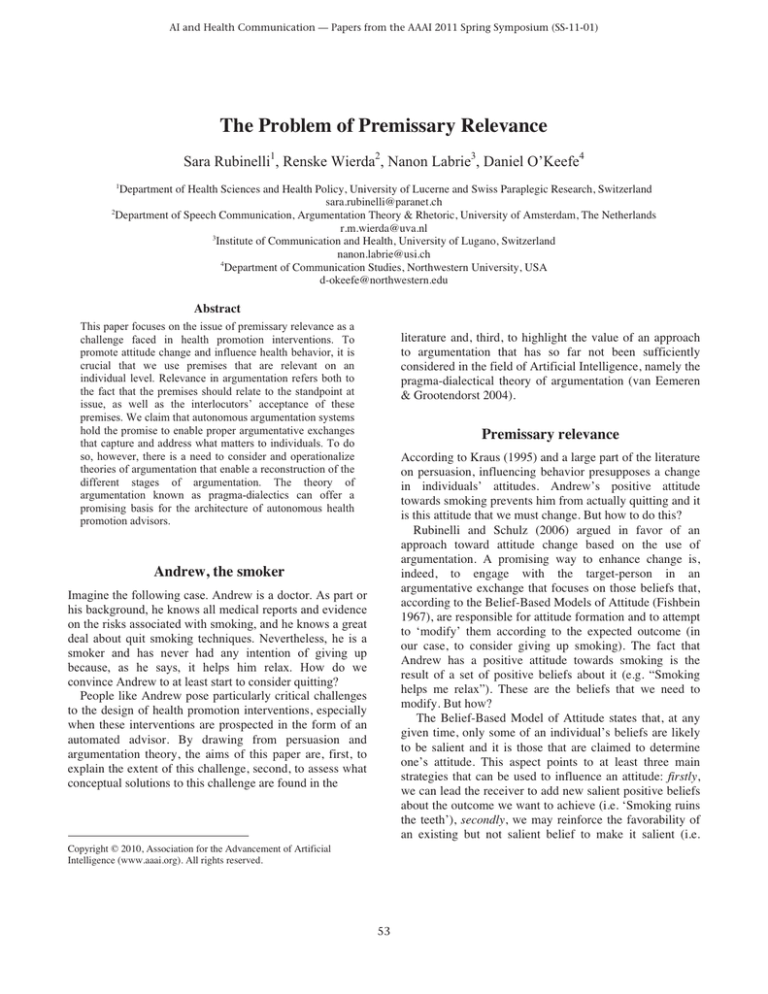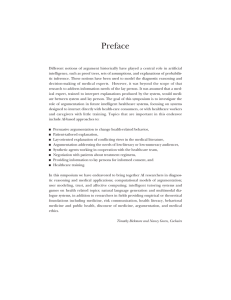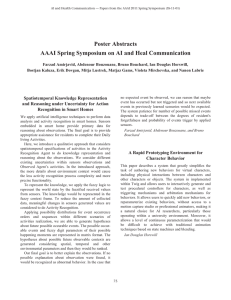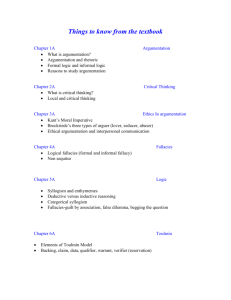
AI and Health Communication — Papers from the AAAI 2011 Spring Symposium (SS-11-01)
The Problem of Premissary Relevance
Sara Rubinelli1, Renske Wierda2, Nanon Labrie3, Daniel O’Keefe4
1
Department of Health Sciences and Health Policy, University of Lucerne and Swiss Paraplegic Research, Switzerland
sara.rubinelli@paranet.ch
2
Department of Speech Communication, Argumentation Theory & Rhetoric, University of Amsterdam, The Netherlands
r.m.wierda@uva.nl
3
Institute of Communication and Health, University of Lugano, Switzerland
nanon.labrie@usi.ch
4
Department of Communication Studies, Northwestern University, USA
d-okeefe@northwestern.edu
Abstract
This paper focuses on the issue of premissary relevance as a
challenge faced in health promotion interventions. To
promote attitude change and influence health behavior, it is
crucial that we use premises that are relevant on an
individual level. Relevance in argumentation refers both to
the fact that the premises should relate to the standpoint at
issue, as well as the interlocutors’ acceptance of these
premises. We claim that autonomous argumentation systems
hold the promise to enable proper argumentative exchanges
that capture and address what matters to individuals. To do
so, however, there is a need to consider and operationalize
theories of argumentation that enable a reconstruction of the
different stages of argumentation. The theory of
argumentation known as pragma-dialectics can offer a
promising basis for the architecture of autonomous health
promotion advisors.
literature and, third, to highlight the value of an approach
to argumentation that has so far not been sufficiently
considered in the field of Artificial Intelligence, namely the
pragma-dialectical theory of argumentation (van Eemeren
& Grootendorst 2004).
Premissary relevance
According to Kraus (1995) and a large part of the literature
on persuasion, influencing behavior presupposes a change
in individuals’ attitudes. Andrew’s positive attitude
towards smoking prevents him from actually quitting and it
is this attitude that we must change. But how to do this?
Rubinelli and Schulz (2006) argued in favor of an
approach toward attitude change based on the use of
argumentation. A promising way to enhance change is,
indeed, to engage with the target-person in an
argumentative exchange that focuses on those beliefs that,
according to the Belief-Based Models of Attitude (Fishbein
1967), are responsible for attitude formation and to attempt
to ‘modify’ them according to the expected outcome (in
our case, to consider giving up smoking). The fact that
Andrew has a positive attitude towards smoking is the
result of a set of positive beliefs about it (e.g. “Smoking
helps me relax”). These are the beliefs that we need to
modify. But how?
The Belief-Based Model of Attitude states that, at any
given time, only some of an individual’s beliefs are likely
to be salient and it is those that are claimed to determine
one’s attitude. This aspect points to at least three main
strategies that can be used to influence an attitude: firstly,
we can lead the receiver to add new salient positive beliefs
about the outcome we want to achieve (i.e. ‘Smoking ruins
the teeth’), secondly, we may reinforce the favorability of
an existing but not salient belief to make it salient (i.e.
Andrew, the smoker
Imagine the following case. Andrew is a doctor. As part or
his background, he knows all medical reports and evidence
on the risks associated with smoking, and he knows a great
deal about quit smoking techniques. Nevertheless, he is a
smoker and has never had any intention of giving up
because, as he says, it helps him relax. How do we
convince Andrew to at least start to consider quitting?
People like Andrew pose particularly critical challenges
to the design of health promotion interventions, especially
when these interventions are prospected in the form of an
automated advisor. By drawing from persuasion and
argumentation theory, the aims of this paper are, first, to
explain the extent of this challenge, second, to assess what
conceptual solutions to this challenge are found in the
Copyright © 2010, Association for the Advancement of Artificial
Intelligence (www.aaai.org). All rights reserved.
53
(e.g. ‘I know that smoking is bad, my family complains a
lot about my habit, but I can’t quit it. I tried, but I can’t’).
Beyond scientific knowledge, there are several premises
we could use to address and influence possible factors that
are responsible for Andrew’s habit. But, again, how do we
know which of the proposed theories will capture
Andrew’s individuality? We need an interpersonal
exchange with Andrew where he discloses what is at the
origin of his habit, or he gives us hints to understand it.
So far, one of the most promising ways to capture the
individuality of a person in the perspective of designing an
ad hoc health promotion intervention is known as Tailoring
Health Communication (THC) (Kreuter et al. 2000). THC
has been developed in an attempt to avoid the pitfalls that
have compromised the effectiveness of previous massmedia based approaches, in particular the selection of a
single communication approach to use with a group of
people just because they share a particular characteristic.
Tailored health communication is assessment-based on an
individual level and enables a high individualization of
communication. At the same time, it is truly a population
approach that can potentially reach large populations.
Scholars working on tailoring health communication with
computer technology suggest that we first identify through
a questionnaire those factors most likely to influence a
person’s motivation or ability to make whatever changes in
behavior are necessary to accomplish the program’s goals.
Once these factors have been identified, it is possible to
measure an individual’s status on each of these factors and,
subsequently, tailor a message to each person’s unique
needs based on this information.
Tailored health communication has been proven to be
successful
(Dijkstra
2008).
Yet,
autonomous
argumentation systems could propose a more refined way
of tailoring health communication, with potentially even a
higher impact. Current THC has, indeed, two limitations
that could be improved: firstly, it is not a natural way of
interaction. Individuals who are in the target group of an
intervention of THC must first of all answer a
questionnaire that investigates their personal values,
cultural norms, and social networks. When people are
asked to fill out this type of questionnaire they are, to some
extent, forced to think about everything that could be
relevant to change behavior. Secondly, current THC does
not enable argumentation in the sense of a critical
discussion aimed to resolve a difference of opinion. As
mentioned earlier, whenever we need to change salient
beliefs or to add new beliefs and make them salient, we
need argumentation. In the majority of cases, differences of
opinion are solved by means of conversations, or
argumentative discussions which are aimed at addressing
the individual’s beliefs, attitudes, and standpoints related to
the health behavior at issue. As such, health interventions
are aimed at educating and changing individual’s
viewpoints regarding certain behaviors.
Andrew’s belief that ‘Smoking is unhealthy’) and, thirdly,
we may decrease the belief strength associated with an
existing salient belief (i.e. Andrew’s belief that ‘Smoking
helps him relax’). In an argumentative framework this
means that we can advance premises that are either in favor
of the individual beliefs we want to add or reinforce, or
against the individual beliefs we want to refute. Here we
see the core of the challenge.
In order to be successful in our argumentative
exchanges, we must use contents that for Andrew are
relevant and can, thus, become salient in promoting his
attitude change. While relevance can also refer to the fact
that certain contents have to do with the standpoint at issue
(van Eemeren & Grotendorst 2004), we use the term
personal relevance in the sense that content is relevant if
our interlocutor will accept it as an adequate support of a
standpoint (Blair 1992). Our main question, here, is how to
select content that will be accepted by Andrew. As also
acknowledged by the Elaboration Likelihood Model (Petty
& Cacioppo 1986), in fact, personal relevance is a key
factor for people to engage in critical thinking about their
beliefs and reasons at the origin of a behavior.
Catching what matters to individuals
Results from persuasion research highlighted some main
theories that can guide us in our search of potentially
relevant contents. According to Fishbein et al. (2001 and
2003) there are three main social influence theories that
can be utilized to identify and address the causes of
Andrew’s smoking habit:
• Health Belief Model: it assumes that the salient beliefs
are those resulting from an individual’s rational appraisal
of the risks, benefits and barriers to action (e.g. ‘Smoking
can be bad, but at the moment it is more important that it
helps me relax’);
• Social Cognitive Theory: it acknowledges the influence
of individuals’ social environment. It is a learning theory,
based on the idea that people learn by doing what others do
and that salient beliefs can result by conforming to this
(e.g. ‘All my friends smoke’);
• Theory of reasoned action (TRA): it proposes that one’s
intention to perform or not perform a given behavior is a
function of two factors: one’s attitude toward the behavior
in question and one’s subjective norm, i.e. the perception
of whether important others desire the performance or
nonperformance of the behavior (e.g. ‘I continue smoking
because I like it and despite the fact that my wife
complains about it all the time’). An extension of the TRA
is represented by the Theory of Planned Behavior (TPB)
that introduces a third predictor of behavior, namely a
person’s perceived ability to perform or control a behavior
54
Argumentation systems hold the promise to enable such
an argumentative exchange through naturalistic dialogue
with the persuadee. But this promise is still some way off.
The interest for argumentation theory and practice in the
field of Artificial Intelligence is clear. Yet, so far the main
emphasis has been given to argumentation theories focused
on the validity of arguments and on their soundness
according to Toulmin’s theory of reasoning (Bench-Capon
& Dunne 2007). This emphasis is crucial in theoretical
reasoning where agents try to make their beliefs fit the
world. Yet, in the context of health promotion, the focus
shifts from theoretical to practical reasoning. To design an
autonomous argumentation system, we need theories of
argumentation that, apart from looking at validity, also
operationalize the dialectical dimension of a critical
discussion. Thus, whereas Toulmin’s model of argument
schemes is focused primarily on argumentation as a
product, it would be interesting to look into theories that
also shed light on argumentation as a process, taking place
between two discussion parties. Some research in AI
proposed to use Perelman’s theory (Bench-Capon &
Dunne 2007). But Perelman, although he focused on the
‘audience’ dimension and offered a rich list of argument
schemes, did not conceptualize the different stages of a
critical discussion and the nature and quality of the moves
that can occur there. Such an idea of discussion stages
could be useful for argumentation systems, as it involves
the process of defining the starting points that two
opposing discussants have in common, and the way
argumentation is based upon these shared starting points.
This provides an insight in the way an arguer can select
content which has personal relevance for the person he
would like to convince. This type of conceptualization is at
the basis of another theory of argumentation that so far
seems to be unknown in the field of AI, namely pragmadialectics. In the following section we highlight why
pragma-dialectics is a promising theory to inform the
design of argumentation systems.
resolution process. For example, Rule 1 postulates that
during the discussion, parties may not prevent each other
from advancing a standpoint. Engaging in a personal attack
of one’s opponent constitutes a violation of this rule and is
therefore considered a fallacious move of argumentation .
In pragma-dialectics, in a similar fashion, all rule
violations are considered fallacies.
Most significantly, thereby, pragma-dialectics presents
us with a norm of reasonableness: arguments are deemed
unreasonable if they constitute an impediment to the
resolution of a difference of opinion. Such an instrumental
norm of reasonableness, in pragma-dialectical terms, has
advantages over theories such as Toulmin’s, which state
that an argument is sound when its warrant is supported by
sufficient backing. While it is not always clear what could
be seen as ‘sufficient’ backing, a norm of instrumental
reasonableness consisting of a fixed set of rules provides a
clear account as to what is deemed reasonable
argumentation and what is not. Such a normative
perspective on reasonableness can prove to be of great
value when aiming to design automated models of health
interventions.
Research has shown how reasonable argumentation in
the pragma-dialectical sense is generally perceived by
ordinary language users as more convincing than fallacious
argumentation (see, for instance, O’Keefe 2003 and Van
Eemeren, Garssen & Meuffels 2009). Consequently, it can
be said that it is useful for health campaigners to argue in
such a way that rule violations are avoided at all times.
For, a campaign based on reasonable arguments is more
likely to stimulate the intended behavior than a campaign
using fallacious argumentation. Though obviously also
other factors play an important part when it comes to
influencing an individual’s behavior, conviction can be
seen to play a significant role in the process. If Andrew is
reasonably convinced by the campaigner that the
standpoint ‘Smoking helps me relax’ is not acceptable, this
will result in a change of belief – a belief that can reshape
his attitude and intention towards the behavior change and,
subsequently, even his actual behavior.
In addition to the above, pragma-dialectics can also be
regarded valuable for the field of automated intervention
design as it may shed a new light upon the different stages
an argumentative discussion is composed of. In the ideal
model of a critical discussion, the discussants proceed
through four stages: a confrontation stage, an opening
stage, an argumentation stage, and a concluding stage.
Each of these stages serves a specific purpose in the
resolution process (see, e.g., Van Eemeren & Grootendorst
2004). Though the ideal model rarely occurs in reality in
this exact form, pragma-dialecticians propose that while
some argumentative moves take place in an implicit way,
they can always be reconstructed as part of a critical
discussion. In aiming to catch what matters to individuals,
the opening stage is of notable importance. In this stage, it
is determined which starting points are shared by both
Constructing argumentation through
pragma-dialectics
The pragma-dialectical argumentation theory (van
Eemeren & Grootendorst 2004) essentially starts from the
concept of a critical discussion aimed at resolving a
difference of opinion between two parties. In the opening
example, Andrew should be regarded as one of those
parties, while the health campaigner addressing his
smoking habit should be considered as his opposing party.
In addition, the theory presents a code of conduct for a
reasonable discussion, by means of ten dialectical
discussion rules that prohibit those moves that hinder the
55
discussants (for if you do not agree about any premise,
there’s no use in trying to resolve a difference of opinion).
This often happens in an implicit way. Yet, discussants can
also try to gain explicit concessions from each other, for
instance, by asking each other questions. In this way, they
can try to widen the ‘zone of agreement’ in a discussion.
Now, in order to advance an argument that will be
personally relevant to the one you want to convince, it is
opportune to make a selection out of the possible
arguments in such a way that it maximally corresponds to
the starting points that you share with your opponent. In
pragma-dialectics, such a selection is considered a form of
strategic maneuvering (Van Eemeren 2010), meaning that
you try to be as rhetorically persuasive as possible while
still adhering to the dialectical rules. This maneuvering –
which can be regarded as a specific form of individual
tailoring – can be done by (1) choosing a certain move
from the topical potential of all the moves available to you
at that moment, by (2) adapting to your intended audience
as much as possible, and by (3) choosing certain
presentational devices. In the case of choosing content that
Andrew will believe to be personally relevant, a health
campaigner will have to maneuver strategically with his
choice from the topical potential, in such a way that he
chooses arguments that correspond to the starting points
that are shared between him and Andrew. In terms of the
topical potential for argumentative moves, use can be made
of theoretical models such as the Health Belief Model,
Social Cognitive Theory, and the Theory of Reasoned
Action. These theories can provide us with possible
arguments regarding attitudes toward behavior, behavioral
intention, risks and benefits, subjective norms, and more.
To determine which of these possible arguments
correspond most to Andrew’s starting points, one has to
look at the (reconstructed) opening stage of the discussion
with Andrew and consider all of his concessions, implicit
commitments and explicit statements. While a
questionnaire could be reconstructed as an explicit opening
stage (since Andrew’s answers to the questions could be
seen as concessions), it is also possible to consider implicit
commitments Andrew has made, using reconstruction
methods offered by speech act theory and pragmadialectics. Also, general background information regarding
Andrew, such as his age, his medical history and how long
he has been smoking, can be used to distill starting points.
conceptualization of argumentation as a dynamic and
dialectical process, ruled by norms of reasonableness.
References
Bench-Capon, T.J.M, and Dunne, P.E. 2007. Argumentation in
artificial intelligence. Artificial Intelligence 171: 619-641.
Blair, J.A. 1992. Premissary relevance. Argumentation 6: 203217.
Dijkstra, A. 2008. The psychology of tailoring-ingredients in
computer-tailored persuasion. Social and Personality Psychology
Compass 2: 765-784.
Eemeren, F.H. van, and Grootendorst, R. 2004. A Systematic
Theory of Argumentation: The Pragma-Dialectical Approach.
Cambridge, UK: Cambridge University Press.
Eemeren, F.H. van 2010. Strategic maneuvering in argumentative
discourse. Amsterdam: John Benjamins.
Eemeren, F.H. van, Garssen, B.J., and Meuffels, B.
2009. Fallacies and judgments of reasonableness:empirical
research concerning the pragma-dialectical discussion
rules. Dordrecht: Springer.
Fishbein, M. 1967. Attitude and the prediction of behavior. In M.
Fishbein (ed.), Readings in attitude theory and measurement (pp.
477-492). New York: John Wiley.
Fishbein, M., Triandis, H.C., Kanfer, F.H., Becker, M.,
Middlestadt, S.E., and Eichelt, A. 2001. Factors influencing
behavior and behavior change. In A. Baum, T.A. Revenson, and
J.E. Singer (Eds.), Handbook of health psychology (pp. 3-15).
Mahwah, NJ: Lawrence Erlbaum Associates.
Fishbein, M., and Ajzen, I. 2003. Using theory to design effective
health behavior interventions. Communication Theory 13: 164183.
Kraus, S.J. 1995. Attitudes and the prediction of behavior: a
meta-analysis of the empirical literature. Personality and Social
Psychology Bulletin 21: 58-75.
Kreuter, M., Farrell, D., Olevitch, L., and Brennan, L. 2000.
Tailoring Health Messages. Mahwah, NJ: Lawrence Erlbaum
Associates
O'Keefe, D.J. 2003. The potential conflict between normativelygood argumentative practice and persuasive success: evidence
from persuasion effects research. In F. H. van Eemeren, J.A.
Blair, C.A. Willard, and A.F. Snoech Henkemans (eds.), Anyone
who has a view: theoretical contributions to the study of
argumentation (pp. 309-318). Amsterdam: Kluwer.
Petty, R.E., and Cacioppo, J.T. 1986. Communication and
persuasion: central and peripheral routes to attitude change.
New York: Springer-Verlag.
Rubinelli, S., and Schulz, P.J. 2006. Let me tell you why! When
argumentation in doctor-patient interaction makes a difference.
Argumentation 20: 353-375.
To Conclude
In this contribution we invite scholars active in the design
of argumentation systems to address the problem of
premissary relevance by exploiting the value of pragmadialectics. Though we do not claim that this is the only
theory to be used, or that it does not have any
disadvantages, we do believe that it would benefit the field
of
Artificial
Intelligence
by
advancing
the
56





